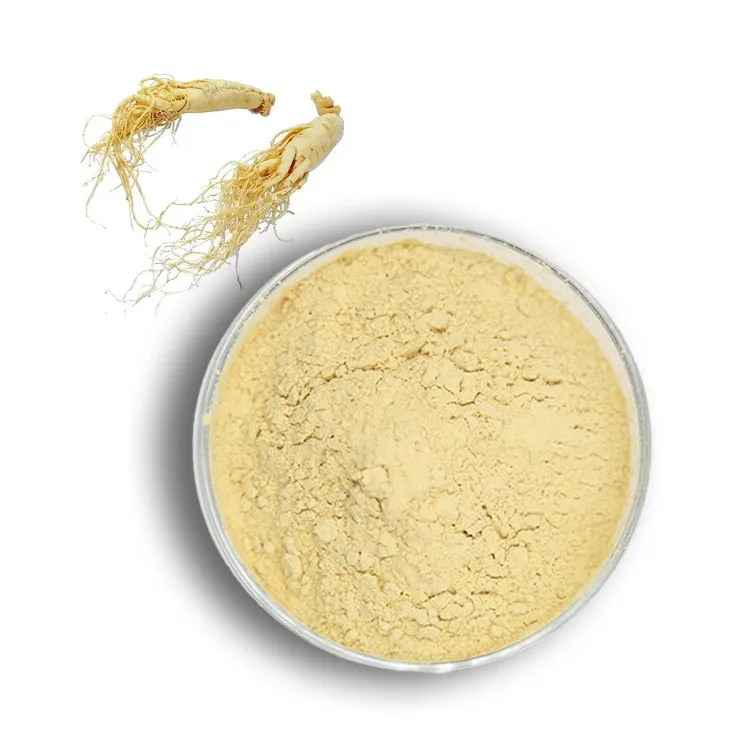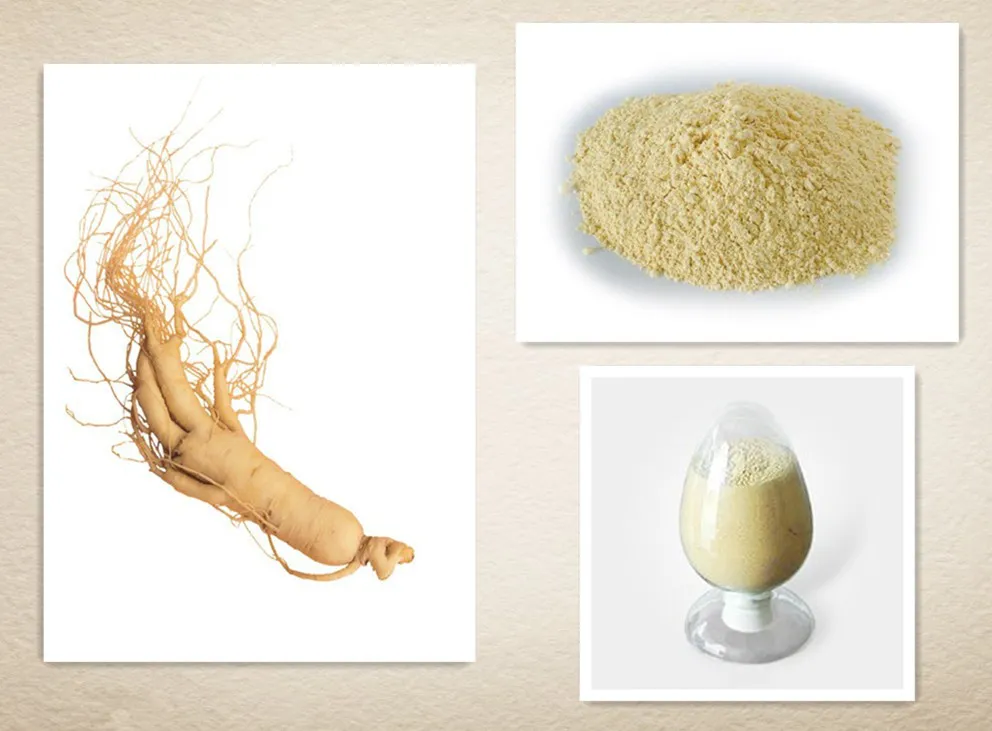- 0086-571-85302990
- sales@greenskybio.com
Extraction process of ginseng root extract.
2024-11-29

1. Introduction
Ginseng has been highly valued in traditional medicine for centuries due to its numerous potential health benefits. Ginseng Root Extract is a concentrated form that contains the active compounds of ginseng. Understanding the extraction process is crucial for obtaining a pure and effective product. This article will explore the in - depth extraction process, including traditional and modern methods, factors influencing the extraction, and the significance of each step.

2. Traditional extraction methods
2.1 Decoction
- The first step in the decoction method is to clean the ginseng roots thoroughly to remove any dirt or impurities. This is a very basic but important step as contaminants can affect the quality of the extract.
- Next, the clean roots are chopped into small pieces. This increases the surface area of the roots, allowing for better extraction of the active compounds during the boiling process.
- The chopped ginseng roots are then placed in a pot with a suitable amount of water. The ratio of ginseng to water is an important factor. Generally, a ratio of about 1:5 to 1:10 (ginseng: water) is often used, but this can vary depending on the desired concentration of the extract.
- The pot is then heated and the mixture is brought to a boil. The boiling process should be maintained for a certain period, usually around 1 - 3 hours. During this time, the heat causes the active compounds in the ginseng roots, such as ginsenosides, to dissolve into the water.
- After boiling, the resulting liquid is allowed to cool. Once cooled, it can be filtered through a fine - mesh sieve or cheesecloth to remove any solid particles, leaving behind a relatively crude Ginseng Root Extract.
2.2 Maceration
- Similar to decoction, the ginseng roots need to be cleaned and chopped into small pieces for the maceration process.
- The chopped roots are then placed in a container and covered with a solvent. Traditionally, this solvent could be water, alcohol (such as ethanol), or a mixture of both. For example, a common mixture is 70% ethanol - 30% water. The choice of solvent depends on the solubility of the desired active compounds. Ethanol - water mixtures are often preferred as they can dissolve a wider range of compounds compared to water alone.
- The container is then sealed to prevent evaporation of the solvent. The ginseng - solvent mixture is left to stand at room temperature for an extended period, which can range from several days to a few weeks. During this time, the solvent gradually extracts the active components from the ginseng roots through diffusion.
- After the maceration period, the liquid is filtered to separate it from the solid ginseng residue. This filtered liquid is the Ginseng Root Extract obtained through the maceration method.

3. Modern extraction methods
3.1 Soxhlet extraction
- The ginseng roots are first dried and ground into a fine powder. This step is important as it maximizes the surface area of the ginseng material, enabling more efficient extraction.
- A Soxhlet extractor is set up. The ground ginseng powder is placed in a thimble, which is then inserted into the Soxhlet extractor. A suitable solvent, such as ethanol or a mixture of solvents, is placed in the main chamber of the extractor.
- The Soxhlet extraction process is then started. The solvent is heated to boiling in the main chamber. The vapors of the boiling solvent rise, pass through a condenser, and then drip back onto the ginseng powder in the thimble. This continuous cycle of solvent evaporation, condensation, and dripping back onto the sample gradually extracts the active compounds from the ginseng powder.
- Once the extraction is complete, which can take several hours depending on the nature of the ginseng sample and the solvent used, the solvent containing the extracted compounds is collected. This solution can then be further processed, such as by evaporation of the solvent to obtain a more concentrated ginseng root extract.
3.2 Supercritical fluid extraction (SFE)
- In SFE, carbon dioxide (CO₂) is often used as the supercritical fluid. First, the ginseng roots are dried and ground into a fine powder. The powder is then placed in the extraction chamber.
- The CO₂ is pressurized and heated to its supercritical state. In this state, CO₂ has properties that are intermediate between a gas and a liquid, which makes it an excellent solvent for extracting the active compounds from ginseng roots. It has a relatively low viscosity and high diffusivity, allowing it to penetrate the ginseng powder easily.
- The supercritical CO₂ is passed through the ginseng powder in the extraction chamber. As it flows through, it extracts the desired compounds, such as ginsenosides. The extraction process can be controlled by adjusting parameters such as pressure, temperature, and flow rate of the supercritical fluid.
- After the extraction, the supercritical CO₂ containing the extracted compounds is passed through a separator. By reducing the pressure or changing the temperature, the CO₂ reverts to its gaseous state, leaving behind the extracted compounds, which can be collected as the ginseng root extract.

4. Factors influencing the extraction
4.1 Type of ginseng
Different types of ginseng, such as Panax ginseng (Asian ginseng) and Panax quinquefolius (American ginseng), may have different chemical compositions. For example, the content and types of ginsenosides can vary. This means that the extraction process may need to be optimized differently for each type of ginseng to ensure the maximum extraction of the desired active compounds.
4.2 Solvent selection
- As mentioned earlier, the choice of solvent is crucial. Water is a polar solvent and is good for extracting polar compounds. However, some non - polar or less - polar compounds in ginseng may not be well - extracted with water alone. Ethanol, on the other hand, is a more versatile solvent as it can dissolve both polar and non - polar compounds to some extent.
- The concentration of the solvent also matters. For example, different concentrations of ethanol - water mixtures can result in different extraction efficiencies. A higher ethanol concentration may be better for extracting certain hydrophobic compounds, while a lower concentration may be more suitable for polar compounds.
4.3 Temperature
- Temperature has a significant impact on the extraction process. In traditional methods like decoction, a higher temperature can speed up the extraction of active compounds as it increases the solubility and the rate of diffusion. However, if the temperature is too high, it may also cause the degradation of some heat - sensitive compounds in ginseng.
- In modern methods such as supercritical fluid extraction, precise control of temperature is required to maintain the supercritical state of the fluid (e.g., for CO₂) and to optimize the extraction of the desired compounds.
4.4 Particle size
- The size of the ginseng particles affects the extraction efficiency. Smaller particles have a larger surface area, which allows for more contact with the solvent and thus better extraction. For example, in Soxhlet extraction, grinding the ginseng roots into a fine powder can significantly improve the extraction yield.
- However, if the particles are too small, it may also cause problems such as clogging in some extraction equipment or increased difficulty in separating the solid from the liquid after extraction.
4.5 Extraction time
- The length of the extraction time is an important factor. In methods like maceration, a longer extraction time generally results in more complete extraction of the active compounds. However, there is a point of diminishing returns, and after a certain time, further extraction may not significantly increase the yield or may even introduce impurities.
- In modern extraction methods like Soxhlet extraction, the extraction time needs to be optimized based on the nature of the ginseng sample, the solvent, and the extraction equipment to ensure efficient extraction without wasting time or resources.

5. Significance of each step in the extraction process
5.1 Cleaning
Cleaning the ginseng roots is the first and essential step. Removing dirt, debris, and other contaminants ensures that the extract is pure and free from unwanted substances that could affect its quality and safety. If not properly cleaned, these contaminants could introduce bacteria, fungi, or other impurities into the extract, which may have adverse effects on its medicinal properties or even cause health risks when consumed.
5.2 Chopping or grinding
- Chopping the ginseng roots (in traditional methods) or grinding them into a powder (in modern methods) significantly increases the surface area of the ginseng material. This increased surface area allows for more efficient extraction as it provides more contact points for the solvent to interact with the active compounds in the ginseng roots.
- For example, in Soxhlet extraction, the fine powder of ginseng enables the solvent to penetrate more easily and extract the compounds more thoroughly compared to whole or large - piece ginseng roots.
5.3 Solvent addition
- The addition of the appropriate solvent is crucial for dissolving the active compounds in ginseng roots. Different solvents have different solubilities for various compounds, so choosing the right solvent or solvent mixture is essential for obtaining a comprehensive extract. For example, a water - ethanol mixture can extract a wider range of ginsenosides compared to using water or ethanol alone.
- The solvent also serves as a medium for transporting the extracted compounds out of the ginseng material. Without a suitable solvent, the extraction process would not be possible.
5.4 Heating or pressurizing (in modern methods)
- In methods like decoction, heating is used to increase the solubility of the active compounds in the solvent and to speed up the extraction process. By raising the temperature, the molecules of the active compounds gain more energy and are more likely to dissolve into the solvent.
- In modern methods such as supercritical fluid extraction, pressurizing the supercritical fluid (e.g., CO₂) is necessary to achieve its supercritical state. In this state, the fluid has unique properties that make it an efficient solvent for extracting the active compounds from ginseng roots.
5.5 Filtration
- Filtration is an important step to separate the liquid extract from the solid residue. It ensures that the final extract is free from solid particles, which could affect its clarity, stability, and usability. For example, in decoction and maceration methods, filtering the extract after extraction removes any remaining pieces of ginseng roots, making the extract more suitable for further processing or consumption.
- Proper filtration also helps in removing any insoluble impurities that may have been present in the raw ginseng material or formed during the extraction process.

6. Conclusion
The extraction process of ginseng root extract is a complex yet important process. Whether using traditional or modern methods, each step and factor plays a crucial role in obtaining a pure and effective product. Understanding these processes and factors can help in the optimization of ginseng root extract production, ensuring that the final product contains the maximum amount of desired active compounds while maintaining its quality and safety.
FAQ:
1. What are the traditional methods for extracting ginseng root extract?
Traditional methods for extracting ginseng root extract often include maceration and decoction. Maceration involves soaking the ginseng roots in a solvent (such as alcohol or water) for an extended period. Decoction is the process of boiling the ginseng roots in water to extract the active components. These traditional methods are relatively simple but may not be as efficient in terms of extracting all the valuable compounds compared to modern techniques.
2. What are the modern extraction methods for ginseng root extract?
Modern extraction methods for ginseng root extract include supercritical fluid extraction (SFE), ultrasonic - assisted extraction (UAE), and microwave - assisted extraction (MAE). Supercritical fluid extraction uses supercritical carbon dioxide as a solvent, which has the advantages of being non - toxic, non - flammable, and having a high diffusivity. Ultrasonic - assisted extraction utilizes ultrasonic waves to enhance the mass transfer rate during extraction. Microwave - assisted extraction uses microwaves to heat the extraction system, which can significantly shorten the extraction time and improve the extraction efficiency.
3. What factors can influence the extraction of ginseng root extract?
Several factors can influence the extraction of ginseng root extract. The type of solvent used is crucial, as different solvents have different solubilities for the active components in ginseng. The particle size of the ginseng roots also matters; smaller particle sizes generally lead to a larger surface area and better extraction efficiency. Temperature, extraction time, and the ratio of solvent to sample are other important factors. Higher temperatures may increase the solubility of the components but may also cause degradation of some heat - sensitive compounds. Longer extraction times may not always result in better extraction, and an appropriate solvent - to - sample ratio needs to be determined to ensure efficient extraction.
4. Why is each step in the extraction process of ginseng root extract significant?
Each step in the extraction process of ginseng root extract is significant. For example, in the pre - treatment step, cleaning and drying the ginseng roots properly can remove impurities and ensure the quality of the raw material. During the extraction step, the choice of method and the control of parameters are crucial for obtaining a high - quality extract. The purification step is important to remove unwanted substances and concentrate the active components. And the final drying and packaging steps are necessary to preserve the stability and quality of the extract.
5. How can we ensure the purity of ginseng root extract?
To ensure the purity of ginseng root extract, multiple steps can be taken. Firstly, high - quality ginseng roots should be selected as the raw material. During the extraction process, appropriate extraction and purification methods should be used. For example, using advanced chromatographic techniques for purification can effectively separate the active components from impurities. Strict quality control during the entire production process, including monitoring the composition and quality of the extract at each step, is also essential.
Related literature
- Advances in Ginseng Root Extract Extraction Technologies"
- "Traditional and Modern Approaches in Ginseng Root Extract Production"
- "Factors Affecting the Quality of Ginseng Root Extract: An In - Depth Review"
- ▶ Hesperidin
- ▶ citrus bioflavonoids
- ▶ plant extract
- ▶ lycopene
- ▶ Diosmin
- ▶ Grape seed extract
- ▶ Sea buckthorn Juice Powder
- ▶ Beetroot powder
- ▶ Hops Extract
- ▶ Artichoke Extract
- ▶ Reishi mushroom extract
- ▶ Astaxanthin
- ▶ Green Tea Extract
- ▶ Curcumin Extract
- ▶ Horse Chestnut Extract
- ▶ Other Problems
- ▶ Boswellia Serrata Extract
- ▶ Resveratrol Extract
- ▶ Marigold Extract
- ▶ Grape Leaf Extract
- ▶ blog3
- ▶ blog4
-
Nature's best cytisine.
2024-11-29
-
Kudzu root extract suppliers.
2024-11-29
-
The Most Well - received Vitamin B9 Powder.
2024-11-29
-
Suppliers of Organic β - Carotene Powder.
2024-11-29
-
100% Pure Organic Black Garlic Extract.
2024-11-29
-
Avocado Extract Powder
2024-11-29
-
Acai Berry Extract
2024-11-29
-
Curcuma Longa Extract
2024-11-29
-
Mulberry Extract
2024-11-29
-
Echinacea Extract
2024-11-29
-
Astaxanthin
2024-11-29
-
Acerola Juice Powder
2024-11-29
-
Almond Extract Powder
2024-11-29
-
Camu Camu Extract
2024-11-29
-
Troxerutin
2024-11-29





















